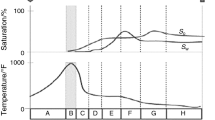Abstract
Present study investigates thermal behavior of two heavy crude oils with different °API values by simultaneous thermogravimetry–differential scanning calorimetry–fourier transform infrared spectroscopy (TG–DSC–FTIR), and an evaluation of the chemical element levels present in the oils’ ashes was done by energy dispersive X-ray fluorescence spectrometry. TG and DSC curves were obtained for two samples in nitrogen atmosphere. Among all inorganic components evaluated, the highest concentration in the two oils was SO3. Thus this study may contribute to a better understanding of the thermal behavior of heavy crude oils and their composition.









Similar content being viewed by others
References
Meyer RF, Attanasi E. Heavy oil and natural bitumen resources in geological basins of the world. Open File Report 2007-1084. US Geological Survey; 2003.
Mothé MG. Doctoral Thesis. Outflow of heavy oils: with emphasis on polymer dispersions and rheological characterization. 210p. EQ/UFRJ. 2012.
Ali MA, Siddiqui MAB, Zaidi SMJ. Thermal analysis of crude oils and comparison with SIMDIST and TBP distillation data. J Therm Anal Calorim. 1998;51:307–19.
Laux H, Butz T, Rahimian I. Thermogravimetric investigation of the influence of colloidal phase on the processing properties of crude oil residues. Oil Gas Sci Technol. 2000;55:315–20.
Kök MV, Létoffe J-M, Claudy P, Martin D, Garcin M, Volle J-L. Comparison of wax appearance temperatures of crude oils by differential scanning calorimetry, thermomicroscopy and viscometry. Fuel. 1996;75(7):787–90.
Mothé MG, Carvalho CHM, Sérvulo EFC, Mothé CG. Kinetic study of heavy crude oils by thermal analysis. J Therm Anal Calorim. 2012. doi:10.1007/s10973-012-2574-1.
Xie W, Pan W-P. Thermal characterization of materials using evolved gas analysis. J Therm Anal Calorim. 2001;65:669–85.
Raje N, Aacherekar DA, Reddy AVR. Compositional characterization of carbon electrode material: a study using simultaneous TG–DTA–FTIR. Thermochim Acta. 2009;496:143–50.
Wastowski AD, Da Rosa GM, Cherubin MR, Rigon JPG. Caracterização dos níveis de elementos químicos em solo, submetido a diferentes sistemas de uso e manejo, utilizando espectrometria de fluorescência de raios-X por energia dispersiva (EDXRF). Quim Nova. 2010;33(7):1449–52.
Acknowledgments
The authors would like to thank Petrobras, the Brazilian Council for Scientific and Technological Development (CNPq) and the Brazilian Federal Agency for Support and Evaluation of Graduate Education (CAPES) for their financial support and NETZSCH-Geratebau GmbH Applications Laboratory.
Author information
Authors and Affiliations
Corresponding author
Rights and permissions
About this article
Cite this article
Mothé, M.G., Mothé, C.G., de Carvalho, C.H.M. et al. Thermal investigation of heavy crude oil by simultaneous TG–DSC–FTIR and EDXRF. J Therm Anal Calorim 113, 525–531 (2013). https://doi.org/10.1007/s10973-013-3124-1
Received:
Accepted:
Published:
Issue Date:
DOI: https://doi.org/10.1007/s10973-013-3124-1




